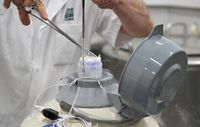A recent scandal in the Netherlands has revealed alarming practices regarding sperm donation, as at least 85 sperm donors have exceeded the legal limits set by the country, resulting in the birth of potentially hundreds of children. This shocking news comes on the heels of a new law that mandates a national registry for all sperm donors, shedding light on a situation that many had long suspected but few could confirm.
According to a report by the Dutch society of obstetrics and gynecology (NVOG), aired on April 14, 2025, the number of children that can be conceived from a single donor was previously capped at 25 until 2018. However, this limit was reduced to just 12 families, a regulation that only came into effect this month. The implications of this change are profound, as many so-called "mega-donors" have fathered between 26 to 40 children, with some reportedly fathering as many as 75.
Marieke Schoonenberg, a gynecologist and spokesperson for the NVOG, acknowledged the gravity of the situation. "The number of mass donors in clinics should have been zero," she stated during the program Nieuwsuur. The revelations are particularly troubling given that the new law, which created a national registry to track all gamete donations since 2004 (the year anonymous donations were banned), has only recently come into effect.
Prior to this registry, individual hospitals maintained their own records, allowing some donors to contribute sperm at multiple clinics without any coordination. This lack of oversight led to cases where clinics reused sperm samples without proper documentation, often without the consent of the donors or the mothers involved.
The NVOG has since apologized for these breaches of trust, urging families affected by the situation to contact fertility centers for clarification. The organization’s admission comes amid growing concerns about the impact of these practices on family dynamics and the potential for accidental incest among half-siblings.
Brenda Frederiks, a mother of two children conceived through sperm donation, recently discovered that her children have as many as 34 biological half-siblings. "This is a nightmare for many families," she expressed, highlighting the emotional toll this revelation can take on those involved.
Moreover, Ties van der Meer, a member of the Dutch foundation Stichting Donorkind, emphasized the broader implications of these findings. He estimated that there could be at least 3,000 children in the Netherlands with 25 or more half-siblings, raising serious concerns about the long-term psychological effects on these individuals. "The damage done to people's trust in the medical system and the governments that allowed this to happen is just beginning," he remarked.
The NVOG's revelations have also drawn attention to the actions of some fertility clinics that allegedly violated regulations by repeatedly using the same donor's sperm without consent. This practice not only contravenes ethical standards but also poses significant risks to the health and wellbeing of the children conceived through these means.
In a related note, the scandal has rekindled discussions about the infamous case of Jonathan Jacob Meijer, a sperm donor who has been linked to the conception of at least 550 children worldwide, including around 100 in the Netherlands. His story, which has been documented in a Netflix series titled "The Man with 1,000 Children," serves as a cautionary tale about the potential for abuse within the sperm donation industry.
Meijer was found to have acted outside the law, and in 2023, he was banned from donating sperm altogether. His case underscores the urgent need for stricter regulations and oversight in the field of assisted reproductive technology.
As the NVOG continues to grapple with the fallout from this scandal, it is clear that the implications of these revelations extend far beyond the immediate concerns of donor limits. The emotional and psychological ramifications for the families involved, as well as the broader societal implications, cannot be overstated.
In light of these events, many are calling for a reevaluation of the laws governing sperm donation in the Netherlands. Advocates argue that a more robust system of tracking and regulating donors is essential to prevent similar situations from occurring in the future.
As discussions continue, the NVOG's commitment to transparency and accountability will be crucial in restoring public trust in the fertility industry. The organization has urged all affected parties, including mothers, donors, and children, to reach out to fertility centers for guidance and support.
In conclusion, the recent findings regarding sperm donation practices in the Netherlands highlight the urgent need for reform in this area. With the potential for thousands of children to be impacted by these revelations, it is imperative that the medical community takes swift action to address these issues and ensure the safety and wellbeing of all parties involved.





